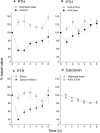Moderate ingestion of alcohol is associated with acute ethanol-induced suppression of circulating CTX in a PTH-independent fashion
- PMID: 19257829
- PMCID: PMC2718797
- DOI: 10.1359/jbmr.090222
Moderate ingestion of alcohol is associated with acute ethanol-induced suppression of circulating CTX in a PTH-independent fashion
Abstract
The "J shape" curve linking the risk of poor bone health to alcohol intake is now well recognized from epidemiological studies. Ethanol and nonethanol components of alcoholic beverages could influence bone remodeling. However, in the absence of a solid underlying mechanism, the positive association between moderate alcoholic intake and BMD remains questionable because of confounding associated social factors. The objective of this work was to characterize the short-term effects of moderate alcohol consumption on circulating bone markers, especially those involved in bone resorption. Two sequential blood-sampling studies were undertaken in fasted healthy volunteers (age, 20-47 yr) over a 6-h period using beer of different alcohol levels (<0.05-4.6%), solutions of ethanol or orthosilicic acid (two major components of beer), and water +/- calcium chloride (positive and negative controls, respectively). Study 1 (24 subjects) assessed the effects of the different solutions, whereas study 2 (26 subjects) focused on ethanol/beer dose. Using all data in a "mixed effect model," we identified the contributions of the individual components of beer, namely ethanol, energy, low-dose calcium, and high-dose orthosilicic acid, on acute bone resorption. Markers of bone formation were unchanged throughout the study for all solutions investigated. In contrast, the bone resorption marker, serum carboxy terminal telopeptide of type I collagen (CTX), was significantly reduced after ingestion of a 0.6 liters of ethanol solution (>2% ethanol; p <or= 0.01, RM-ANOVA), 0.6 liters of beer (<0.05-4.6% ethanol; p < 0.02), or a solution of calcium (180 mg calcium; p < 0.001), but only after calcium ingestion was the reduction in CTX preceded by a significant fall in serum PTH (p < 0.001). Orthosilicic acid had no acute effect. Similar reductions in CTX, from baseline, were measured in urine after ingestion of the test solutions; however, the biological variability in urine CTX was greater compared with serum CTX. Modeling indicated that the major, acute suppressive effects of moderate beer ingestion (0.6 liters) on CTX were caused by energy intake in the early phase (approximately 0-3 h) and a "nonenergy" ethanol component in the later phase (approximately 3 to >6 h). The early effect on bone resorption is well described after the intake of energy, mediated by glucagon-like peptide-2, but the late effect of moderate alcohol ingestion is novel, seems to be ethanol specific, and is mediated in a non-calcitonin- and a non-PTH-dependent fashion, thus providing a mechanism for the positive association between moderate alcohol ingestion and BMD.
Figures






References
-
- De Loromier AA. Alcohol, wine, and health. Am J Surg. 2000;180:357–361. - PubMed
-
- Klatshy AL, Udaltsova N. Alcohol drinking and total mortality risk. Ann Epidemiol. 2007;17:S63–S67.
-
- Jugdaohsingh R, O'Connell MA, Sripanyakorn S, Powell JJ. Moderate alcohol consumption and increased bone mineral density: Potential ethanol and non-ethanol mechanisms. Proc Nutr Soc. 2006;65:291–310. - PubMed
-
- Jugdaohsingh R, Tucker KL, Qiao N, Cupples LA, Kiel DP, Powell JJ. Dietary silicon intake is positively associated with bone mineral density in men and premenopausal women of the Framingham Offspring cohort. J Bone Miner Res. 2004;19:297–307. - PubMed
-
- Jackson R, Broad J, Connor J, Wells S. Alcohol and ischaemic heart disease: Probably no free lunch. Lancet. 2005;366:1911–1912. - PubMed
Publication types
MeSH terms
Substances
Grants and funding
LinkOut - more resources
Full Text Sources
Medical

